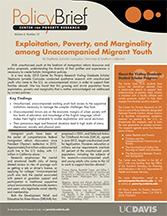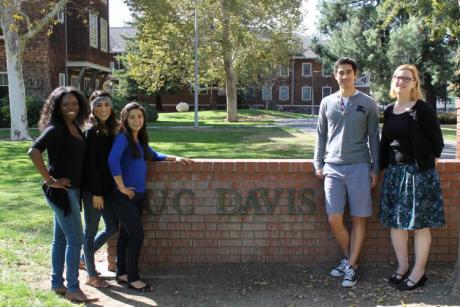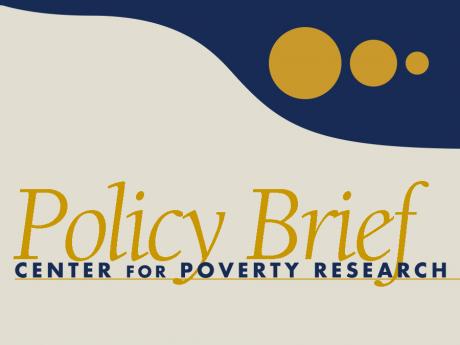Exploitation, Poverty and Marginality among Unaccompanied Migrant Youth
by Stephanie Lynnette Canizales, University of Southern California
With unauthorized youth at the forefront of immigration reform discourse and policy proposals, understanding the diversity of their profiles and experiences is necessary to create holistic immigration policies.
In a new study, 2013 Center for Poverty Research Visiting Graduate Scholar Stephanie Lynnette Canizales conducted qualitative research with unauthorized youth who came to the U.S. as unaccompanied minors in order to support their families abroad. She has found that this growing and at-risk population faces exploitation, poverty and marginality that is neither acknowledged nor addressed by current policies.
Key Findings
- Unauthorized, unaccompanied working youth lack access to the supportive institutions necessary to manage the complex challenges they face.
- Unaccompanied minors are on the economic margins of urban society with low levels of education and knowledge of the English language, which makes them highly vulnerable to worker exploitation and social exclusion.
- Their precarious legal and financial situations lead to high levels of stress, depression, anxiety and physical pain.
Immigrant youth have been at the center of comprehensive federal immigration reform discussions since President Obama’s reelection in 2012. Approximately five million undocumented youth live in the U.S. today, with 1.1 million in California alone.
Research emphasizes the mental and emotional health risks of being denied access to rites of passage such as getting a job or driver’s license, or applying for college. Unaccompanied youth also lack the capital associated with parent or guardian support and participation in traditional supportive school environments that provide mentors and peers who legitimate social identity and membership.
Both the Development, Relief, and Education for Alien Minors (DREAM) Act, proposed in 2001, and Deferred Action for Childhood Arrivals (DACA), signed in June 2012, target unauthorized youth for legalization. However, education or military service requirements overlook 62 percent of the unauthorized youth population, including the subjects of this research—unaccompanied youth and young adults who come to the US to work to support families abroad.
Unaccompanied Immigrant Youth in Los Angeles
This study involved more than a year of ethnographic observations
and in-depth interviews of an informal immigrant youth support
group in Los Angeles. In nearly 200 hours of fieldwork, Canizales
interacted with anywhere between ten and 30 youth at each
meeting, and conducted 15 in-depth interviews to supplement field
observations.
Group members were unauthorized working youth who migrated to Los Angeles as unaccompanied minors with the intention of working to support their families who remained in their countries of origin. They hailed from indigenous Mayan villages in Guatemala where the primary languages spoken are K’iche and Q’anjobal. The highest level of education among them was fourth grade with the exception of one young man who earned a GED after 10 years of study in the U.S. At the time of the study, the respondents were between 18 and 35 years old, and lived in the US between four and nineteen years. They worked in Downtown Los Angeles.
While many of youth like these may qualify for inclusive immigration policies based on age and length-of-stay, they are excluded because they are not enrolled in school. Furthermore, because they live without a parent or guardian, they are often unable to enroll in school and instead work to survive and to sustain their families abroad.
Interviews with the Youth
This study focused on one specific segment of this population:
Guatemalan Maya youth in Los Angeles, California. The youth
entered the U.S. as unaccompanied minors with low-levels of
education and English language knowledge, and started work in
occupations such as garment work, service, construction,
maintenance and domestic work.
The study participants faced extreme exclusion related to their precarious and vulnerable circumstances. Recurring themes during field research included narratives of overwhelming mental and emotional health problems such as depression, stress, anxiety and fear. Many of these youth worked in dimly lit, poorly ventilated garment factories, often for up to 11 hours per day, six days per week, and reported a median of $350 in wages per week. Wage theft—when an employer withholds earned pay—was also commonly reported (An extreme case is that of $8,000 withheld by an employer during a one-year timeframe). Finally, work schedules limited the youths’ ability to attend school and participate in leisure or community events that contribute to mental and physical health.
Overwhelming thoughts and emotions were often tied to reports of poor work conditions, poverty, cultural distance and discrimination. Omar (All names here are pseudonyms to protect study participants’ privacy), an 18 year old garment worker who has spent four years in Los Angeles said he feels stressed that he is working as much as he is but does not make enough money. He also said that his inability to control his thoughts about this stress gives him a headache. He said, “It’s that… It’s just that I don’t know what’s happening inside of me!”
Flor, a 20 year old homemaker and garment worker, who has spent six years in Los Angeles, spoke of how she spends much of her day oscillating between depression and anger, which inhibit her ability to maintain employment or complete housework. She said that her ‘emotions’ cause her to feel ‘hormigas’ (ants) crawling up her back and onto her head.
Ervin, a 19 year old garment worker who has spent three years in Los Angeles, described how he prefers darkness. He said he gets out of work at 7 or 7:30 p.m. each day, when it is dark, then is at work again at 6 a.m. He said, “I do not like the light, I feel like the people will stare at me… There is something inside of me that does not leave me in peace.”
Inclusive Policies and Great Potential
Scholars have recently begun questioning what is lost when
unauthorized youth learn to be illegal. The youth in this study
were different from most unauthorized youth in that they migrated
on their own in order to support their families back home.
Although these youth lack human capital in the standard way of
defining it, they are highly motivated and accomplished
individuals, even though their low levels of education and
knowledge of the English language lead to low earning potential.
Furthermore, their undocumented status and young age makes them
even more exploitable than the average low-wage worker.
These observations and interviews with unaccompanied youth migrants suggest that support services such as financial literacy courses, worker’s rights education, health clinics and support groups might serve to bolster these youth’s health, wellbeing and sense of inclusion.
Current immigration policies such as DACA or the proposed DREAM Act base eligibility on a narrow understanding of undocumented working youth. For these youth, immigration reform could improve enforcement of fair work wages and hours. It would also eliminate the fear of being fired or deported for reporting unfair treatment and work conditions. This may allow youth to pursue the educational and non-work investments necessary for social incorporation, increased aspirations for mobility, and mental and physical health.
Meet the Researcher
Stephanie Lynnette Canizales is a Ph.D. candidate in
Sociology at the University of Southern California. Her research
focuses on the migration and social adaptation experiences of
unauthorized Mayan youth and young-adults in Los Angeles who
migrated as unaccompanied minors.
References
Batalova, Jeanne and
Margie McHugh. 2010. “DREAM vs. Reality: An analysis of Potential
DREAM Act Beneficiaries.” Migration Policy Institute.
Fortuny, Karina, Randolph Capps, and Jeffrey S. Passel. 2007. “The Characteristics of Unauthorized Immigrants in California, Los Angeles County, and the United States.” Washington, D.C.: The Urban Institute.
Gonzales, Roberto G. 2011. “Learning to be Illegal: Undocumented Youth and Shifting Legal Contexts in the Transition to Adulthood.” American Sociological Review, 76. Pp. 602-619.
Gonzales, Roberto and Leo Chavez. 2012. “Awakening to a Nightmare”: Abjectivity and Illegality in the Lives of Undocumented 1.5-Generation Latino Immigrants in the United States.” Anthropology, 53(3).













